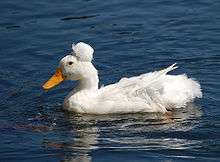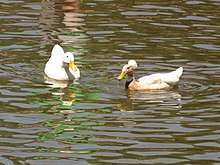Crested (duck breed)
The Crested is a breed of domestic duck. It was probably brought to Europe from the East Indies by Dutch ships.[1]:413 It has its appearance because it is heterozygous for a genetic mutation causing a deformity of the skull.
 Crested duck in the harbor of Camden, Maine | |
| Standard | Poultry Club of Great Britain |
|---|---|
| Traits | |
| Weight | |
| Classification | |
| APA | medium[2] |
| EE | yes[3] |
| PCGB | light[4] |
| |

History
The Crested probably originates in the East Indies, with subsequent development in Holland.[1]:413 Crested ducks are seen in seventeenth-century paintings such as those of Melchior d'Hondecoeter and Jan Steen. Paintings as old as 2000 years have depicted images of a bird, resembling a duck with an assortment of feathers on top of its skull.[5] In the United States the breed was described by D.J. Browne in 1853.[1]:413[6]:197 The white Crested was added to the American Standard of Perfection in 1874; the black variant was added in 1977.[2] The Crested was recognised in the United Kingdom in 1910.[1]:413 In the UK, as in several other European countries, any colour is permitted.[3]
The crest is large and well centered on top of the skull. They have long, slightly arched necks, medium length body, lots of depth and fullness through the breast.[7]
A bantam version of the breed, the Crested Miniature, was bred by John Hall and Roy Sutcliffe in the United Kingdom in the late twentieth century; it was recognised in 1997.[1]:415 The crested gene is very popular in Europe, resulting in crested versions of most breeds.[5] Though Cresteds can be good layers and strong roasting qualities, the main interest and demand for the breed is as pets and decorations. They are not a popular show breed due to challenges associated with the crest.[5]
Breeding
When two ducks heterozygous for the crested allele breed, their eggs are in the usual 1:2:1 genotypic ratio, but live offspring are in a 1:2 ratio as explained below:
- 25% are homozygous for the normal allele of this gene and so have no crest and if bred together their offspring will never have a crest.
- 50% are heterozygous for this gene and hatch with a crest of varying sizes.
- 25% are homozygous for the crested allele of this gene and die from exposed brain without hatching, as it is lethal in homozygous form.
The offspring of a duck with a crest and a duck with no crest are expected to be 50% with and 50% without a crest.
References
- Victoria Roberts (2008). British poultry standards: complete specifications and judging points of all standardized breeds and varieties of poultry as compiled by the specialist breed clubs and recognised by the Poultry Club of Great Britain. Oxford: Blackwell. ISBN 9781405156424.
- APA Recognized Breeds and Varieties: As of January 1, 2012. American Poultry Association. Archived 4 November 2017.
- Liste des races et variétés homologuée dans les pays EE (28.04.2013). Entente Européenne d’Aviculture et de Cuniculture. Archived 16 June 2013.
- Breed Classification. Poultry Club of Great Britain. Archived 12 June 2018.
- Holderread, Dave (2001). Storey's Guide to Raising Ducks. North Adams, MA, USA: Storey Publishing. pp. 58, 59.
- D.J. Browne, Samuel Allen (1853 [1849]). The American poultry yard : comprising the origin, history, and description of the different breeds of domestic poultry, with complete directions for their breeding, crossing, rearing, fattening, and preparation for market …. New York: C.M. Saxton.
- Standard Revision Committee; Malone, Pat; Donnelly, Gerald; Leonard, Walt (2001). American Standard of Perfection 2001. USA: American Poultry Association. p. 312.